Gender Pay Gap Report
What is the Gender Pay Gap?
Organisations with 250 or more employees are required to publish information which shows the difference in pay between male and female employees. These calculations are prescribed by the Government and use various measures to show the difference in the average pay between men and women.
Gender Pay Gap reporting compares the average hourly pay of male and female employees across an organisation. It does not compare what men and women are paid to do the same, or a similar, job and does not measure equal pay. For example, where an organisation has a greater proportion of men in senior management positions, this will create a gap between the average rates of pay for male and female staff. This is the case at the Cumberland.
As required by the regulations, this report relates solely to Cumberland Building Society and excludes staff employed by its subsidiary companies.
Reports
Pay Quartiles
Pay Quartiles show the balance between male and female employees at different levels of pay. Employees are split into four equally sized groups based on their hourly rate of pay and the following charts show the percentage of men and women in each group.
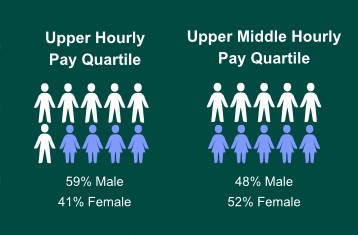
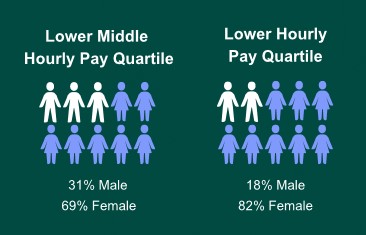
Median and Mean Pay Gap
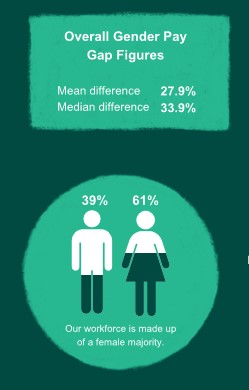
Mean Pay Gap - This is the difference between the average pay for male and female employees taking into account all roles within the Society.
Median Pay Gap - This is the difference between the mid-point of pay for male and female employees taking into account all roles within the Society.
Bonus Pay Gap
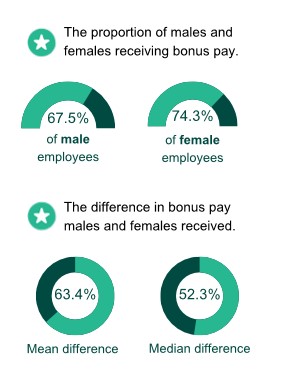
Mean Bonus Gap - This is the difference between the average bonus pay for male and female employees taking into account all roles within the Society.
Median Bonus Gap - This is the difference between the mid-point of bonus pay for male and female employees taking into account all roles within the Society.
What causes the Gender Pay Gap at the Society?
- The financial services sector has a higher Gender Pay Gap than other industries due to the balance between male and female employees across the organisation. The sector sees an over representation of males in senior management and in some functional areas such as Finance, Treasury and Technology. This is reflected in the Society’s figures.
- Female colleagues make up the majority of the workforce at the Cumberland. This is impacted by societal norms around family or work life decisions that may have historically affected the pay trajectory of females more than males. In addition, part time arrangements also impact the bonus gap where there are more females in lower paid positions earning pro rata bonus. Overall, the bonus pay gap is affected by the higher representation of male colleagues in the upper pay quarter. It is also affected by most of the part time colleagues being women, when the legislation doesn’t account for an FTE recalculation of the bonus amounts.
- Whilst we understand what causes the Gender Pay Gap at the Cumberland, society norms, history and legacy layered with an industry context mean that shifting the gender pay gap will take time, however we are committed to making changes that over time will impact this societal and sectoral narrative whilst at the same time respecting the decisions that colleagues make around their work life.
- Both our mean and median hourly pay gaps have continued to reduce compared with 2023, with the mean pay gap reducing for the fourth consecutive year. Pay gaps remain as there is an over-representation of women in lower pay quarters. However, women have moved from the lower pay quarter into the higher quarters and this can be seen in our Gender Pay Gap reporting analysis.
What action is the Society taking to reduce the Gender Pay Gap?
Whilst the gender pay gap can be influenced by several factors we have been taking action across a number of these:
Overrepresentation
Women tend to be overrepresented in low-paying roles whilst been underrepresented in high-paying roles. In some areas this over presentation is starting to change through concerted effort assisted by some of the approaches below.Family Friendly approach
Differences in experience arise from women taking time off or reducing their hours for childcare, which can negatively impact pay progression. We have made changes to our Family Friendly Policies to support both our males and females colleagues and to ensure that life events are supported in a transparent way.Flexible working
The lack of part-time and flexible working opportunities, especially at senior levels, can also contribute to the gender pay gap. We have successfully implemented hybrid working and a more pragmatic approach to part time or flexible working at all levels. Role modelling of this encourages transparency.Consistent Opportunities
The absence of senior female role models and mentors can discourage women from pursuing high-paying careers and we want to ensure this is not the norm at the Cumberland. We are a partner in the Women in Banking and Finance network (WIBF) and have committed to and exceeded progressive targets for female representation at senior levels as a signatory to the HM Treasury Women in Finance Charter. When we signed up to the Charter in October 2018 we had 19% female representation at Board and Executive Level. Our Charter Target was initially set of 33.3% by April 2021, we achieved this target 6 months early. We therefore increased our Charter target to 50% by April 2025 which was achieved as at September 2023. We will continue to track progress, aiming to maintain the 50% representation.
2024 has been a significant year for us as we appointed our first female Chair in the 175 year history of the Cumberland. This is true testament to our progress.
We work hard to secure diverse shortlisting for senior roles, have consistent career discussion as part of our Brighter Performance process and encourage and track females on our learning and mentoring programmes whilst actively participating in a Women’s Leadership Programme. We have a progressive wellbeing agenda linked to our Belonging Strategy which enables transparency around life stage wellbeing such as menopause.
In summary we recognise the benefits that a diverse workforce can bring and have sought to create a culture that attracts, retains and encourages talented people to deliver outstanding performance. This is underpinned by our commitment to build a culture of belonging where our people have opportunity, visibility and voice. A place where everyone feels values.
Whilst there is still much to do we are committed to influencing change.
I can confirm that the information shown above is accurate and in accordance with The Equality Act 2010 (Gender Pay Gap Information) Regulations 2017 in relation to the pay period including 5 April 2024.
Jill Johnston
Chief People & Sustainability Officer

Pay Quartiles
Pay Quartiles show the balance between male and female employees at different levels of pay. Employees are split into four equally sized groups based on their hourly rate of pay and the following charts show the percentage of men and women in each group.
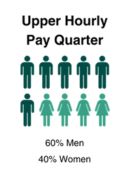
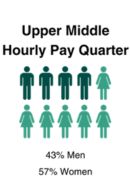
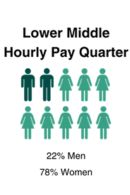
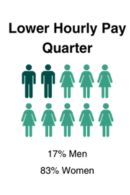
Median and Mean Pay Gap
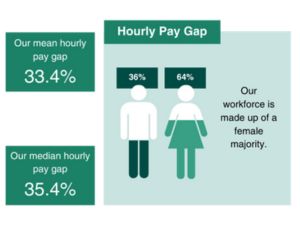
Mean Pay Gap - This is the difference between the average pay for male and female employees taking into account all roles within the Society.
Median Pay Gap - This is the difference between the mid-point of pay for male and female employees taking into account all roles within the Society.
Bonus Pay Gap
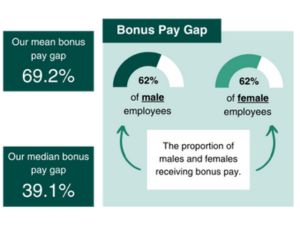
Mean Bonus Gap - This is the difference between the average bonus pay for male and female employees taking into account all roles within the Society.
Median Bonus Gap - This is the difference between the mid-point of bonus pay for male and female employees taking into account all roles within the Society.
What causes the Gender Pay Gap at the Society?
- The financial services sector has a higher Gender Pay Gap than other industries due to the balance between male and female employees across the organisation. The sector sees an over representation of males in senior management and in some functional areas such as Finance, Treasury and Technology. This is reflected in the Society’s figures.
- Female colleagues make up the majority of the workforce at the Cumberland. 94% of part-time colleagues are women, out of which 88% are at Employee level. This is impacted by societal norms around family or work life decisions that may have historically affected the pay trajectory of females more than males. In addition, part time arrangements also impact the bonus gap where there are more females in lower paid positions earning pro rata bonus. Overall, the bonus pay gap is affected by the higher representation of male colleagues in the upper pay quarter. It is also affected by most of the part time colleagues being women, when the legislation doesn’t account for an FTE recalculation of the bonus amounts.
- Whilst we understand what causes the Gender Pay Gap at the Cumberland, society norms, history and legacy layered with an industry context mean that shifting the gender pay gap will take time, however we are committed to making changes that over time will impact this societal and sectoral narrative whilst at the same time respecting the decisions that colleagues make around their work life.
- In turn we are experiencing some changes in our Gender Pay Gap which we can link to the actions articulated in the following section. For example, both the mean and median hourly pay gaps have reduced compared with 2022, with the mean pay gap reducing for the third consecutive year. Pay gaps remain as there is an over-representation of women in lower pay quarters. However, Women have moved from the lower pay quarter into the higher quarters and this can be seen in our Gender Pay Gap reporting analysis.
What action is the Society taking to reduce the Gender Pay Gap?
Whilst the gender pay gap can be influenced by several factors we have been taking action across a number of these:
Overrepresentation
Women tend to be overrepresented in low-paying roles whilst been underrepresented in high-paying roles such as those in technology and finance. In some areas this over presentation is starting to change through concerted effort assisted by some of the approaches below.Family Friendly approach
Differences in experience arise from women taking time off or reducing their hours for childcare, which can negatively impact pay progression. We have made changes to our Family Friendly Policies to support both our males and females colleagues and to ensure that life events are supported in a transparent way.Flexible working
The lack of part-time and flexible working opportunities, especially at senior levels, can also contribute to the gender pay gap. We have successfully implemented hybrid working and a more pragmatic approach to part time or flexible working at all levels. Role modelling of this encourages transparency.Consistent Opportunities
The absence of senior female role models and mentors can discourage women from pursuing high-paying careers we want to ensure this is not the norm at the Cumberland. We are a partner in the Women in Banking and Finance network (WIBF) and have committed and exceeded to progressive targets for female representation at senior levels as a signatory to the HM Treasury Women in Finance Charter. When we signed up to the Charter in October 2018 we had 19% female representation at Board and Executive Level. Our Charter Target was initially set at 33.3% by April 2021, we achieved this target 6 months early. We therefore increased our Charter target to 50% by April 2025 which was achieved as at September 2023. We will continue to track progress, aiming to maintain the 50% representation.
We work hard to secure diverse shortlisting for senior roles, have consistent career discussion as part of our Brighter Performance process and encourage and track females on our learning and mentoring programmes whilst actively participating in a Women’s Leadership Programme.
The lack of female pipeline into many of these roles is a key sectoral challenge and one which continues to affect our Gender Pay Gap reporting. We want to build on our current progress of reducing the gender pay gap. The People data we are building and tracking enables us to have better insight into the recruitment and development of females.
To support this we have a progressive wellbeing agenda linked to our Belonging Strategy which enables transparency around life stage wellbeing such as menopause.
In summary we recognise the benefits that a diverse workforce can bring and have sought to create a culture that attracts, retains and encourages talented people to deliver outstanding performance. This is underpinned by our commitment to build a culture of belonging where our people have opportunity, visibility and voice. A place where everyone feels values.
Whilst there is still much to do we are committed to influencing change.
I can confirm that the information shown above is accurate and in accordance with The Equality Act 2010 (Gender Pay Gap Information) Regulations 2017 in relation to the pay period including 5 April 2023.
Jill Johnston
Chief People Officer

Pay Quartiles
Pay Quartiles show the balance between male and female employees at different levels of pay. Employees are split into four equally sized groups based on their hourly rate of pay and the following charts show the percentage of men and women in each group.
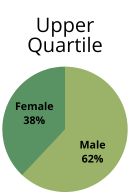
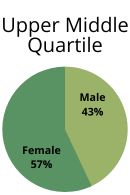
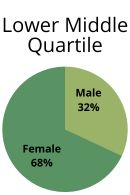
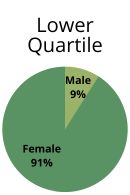
Bonus Pay
| Percentage of male employees who received bonus pay | 70% |
| Percentage of female employees who received bonus pay | 76% |
| Median bonus gap - This is the difference between the mid-point of bonus pay for male and female employees taking into account all roles within the Society | 0% |
| Mean bonus gap - This is the difference between the average bonus pay for male and female employees taking into account all roles within the Society | 74% |
Median and Mean Pay Gap
| Median Pay Gap | This is the difference between the mid-point of pay for male and female employees taking into account all roles within the Society | 37% |
| Mean Pay Gap | This is the difference between the average pay for male and female employees taking into account all roles within the Society | 34% |
What causes the Gender Pay Gap at the Society?
The financial services sector has a higher Gender Pay Gap than other industries due to the balance between male and female employees in senior management positions. This is reflected in the Society’s figures.
What action is the Society taking to reduce the Gender Pay Gap?
We recognise the benefits that a diverse workforce can bring and have sought to create a culture that attracts, retains and encourages talented people to deliver outstanding performance. However, whilst giving active consideration to the balance between male and female employees in senior roles, we believe it is important that appointments are made on merit and against objective criteria.
The Cumberland is a signatory of the Women in Finance Charter which commits firms to supporting progression of women into Senior roles in the financial services sector. The Cumberland had previously set an internal target of having at least 33% of women at Executive and Board Level by April 2021. Having met this target early, we set a new target of 50% by 2025. We are on track to meet this target two years early in April 2023. Our Chief People Officer is Chair for the Women in Finance Building Society and Credit Union Sector Board. We were also a founding partner into pioneering research led by Women in Finance and Banking (WIBF) which seeks to research and address gender issues within our sector. The outputs of this research are seeking to raise the quality of dialogue and action across the industry on gender diversity issues.
We continue to focus on new capability linked to our Cumberland 2025 strategy. Whilst diverse shortlisting has been utilised, the lack of female pipeline into many of these roles is a key sectoral challenge and one which continues to affect our Gender Pay Gap reporting. To facilitate change in this area we continue to build out our people data to help us understand progression through the organisation for females and the impact of our reward strategy on females. Our interventions include providing delegates for female only development programmes, building key third party relationships to stimulate our thinking and activity and monitoring the impact of hybrid working and the flexibility this can bring on our approach to improving our Gender Pay Gap.
Whilst there is still much to do we are committed to influencing change.
I can confirm that the information shown above is accurate and in accordance with The Equality Act 2010 (Gender Pay Gap Information) Regulations 2017 in relation to the pay period including 5 April 2022.
Jill Johnston
Chief People Officer

Pay Quartiles
Pay Quartiles show the balance between male and female employees at different levels of pay. Employees are split into four equally sized groups based on their hourly rate of pay and the following charts show the percentage of men and women in each group.
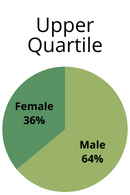
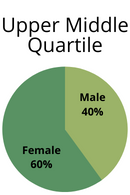
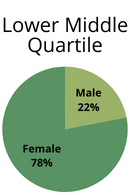
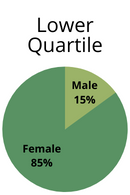
Bonus Pay
| Percentage of male employees who received bonus pay | 30% |
| Percentage of female employees who received bonus pay | 42% |
| Median bonus gap - This is the difference between the mid-point of bonus pay for male and female employees taking into account all roles within the Society | 82.5% |
| Mean bonus gap - This is the difference between the average bonus pay for male and female employees taking into account all roles within the Society | 85% |
Median and Mean Pay Gap
| Median Pay Gap | This is the difference between the mid-point of pay for male and female employees taking into account all roles within the Society | 37% |
| Mean Pay Gap | This is the difference between the average pay for male and female employees taking into account all roles within the Society | 37% |
What action is the Society taking to reduce the Gender Pay Gap?
We recognise the benefits that a diverse workforce can bring and have sought to create a culture that attracts, retains and encourages talented people to deliver outstanding performance. However, whilst giving active consideration to the balance between male and female employees in senior roles, we believe it is important that appointments are made on merit and against objective criteria.
The Cumberland has signed up to the Women in Finance Charter which commits firms to supporting progression of women into Senior roles in financial services sector. When we signed up to the Charter in October 2018 we had 19% female representation at Board and Executive Level. Our Charter Target was initially set of 33.3% by April 2021, we hit this target 6 months early. As of September 2022 this had increased to 46.66%. We have increased our Charter target to 50% by April 2025 and we are on track to achieve this target. Our Chief People Officer has recently been appointed as Chair for the Women in Finance Building Society and Credit Union Sector Board.
We were also a founding partner into pioneering research led by Women in Finance and Banking (WIBF) which seeks to research and address gender issues within our sector. The outputs of this research have resulted in the Good Finance Framework, the Cumberland is seeking to adopt elements of this framework.
We continue to focus on new capability linked to our Cumberland 2025 strategy. Whilst diverse shortlisting has been utilised, the lack of female pipeline into many of these roles is a key sectoral challenge and one which has affected our Gender Pay Gap reporting for 2021. To facilitate change in this area we have provided delegates for female only development programmes.
Whilst we acknowledge as an industry there is still much progress to be made, we continue to spend time talking about this as a key issue and reflecting this theme in the conversations we have around talent management.
I can confirm that the information shown above is accurate and in accordance with The Equality Act 2010 (Gender Pay Gap Information) Regulations 2017 in relation to the pay period including 5 April 2021.
Jill Johnston
Chief People Officer

Pay Quartiles
Pay Quartiles show the balance between male and female employees at different levels of pay. Employees are split into four equally sized groups based on their hourly rate of pay and the following charts show the percentage of men and women in each group.
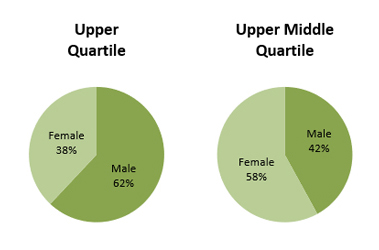
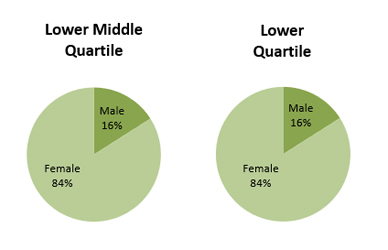
Median and Mean Pay Gap
| Median Pay Gap | This is the difference between the mid-point of pay for male and female employees taking into account all roles within the Society | 36% |
| Mean Pay Gap | This is the difference between the average pay for male and female employees taking into account all roles within the Society | 38% |
Bonus Pay
| Percentage of male employees who received bonus pay | 46% |
| Percentage of female employees who received bonus pay | 60% |
| Median bonus gap - This is the difference between the mid-point of bonus pay for male and female employees taking into account all roles within the Society | 65% |
| Mean bonus gap - This is the difference between the average bonus pay for male and female employees taking into account all roles within the Society | 79% |
What action is the Society taking to reduce the Gender Pay Gap?
We recognise the benefits that a diverse workforce can bring and have sought to create a culture that attracts, retains and encourages talented people to deliver outstanding performance. However, whilst giving active consideration to the balance between male and female employees in senior roles, we believe it is important that appointments are made on merit and against objective criteria.
The Cumberland has signed up to the Women in Finance Charter which commits firms to supporting progression of women into Senior roles in financial services sector. When we signed up to the Charter in October 2018 we had 19% female representation at Board and Executive Level. Our Charter Target was initially set at 33.3% by April 2021, we hit this target 6 months early. As of September 2021 this had increased to 42.85%. We have increased our Charter target to 50% by April 2025. We have also committed as a founding partner into pioneering research led by WIFB which seeks to research and address gender issues within our sector.
During 2020 we were able to conduct a female only external search for two new Non Executive Directors to join our Board, we achieved this targeted appointment in Spring 2021.
2020 was a year when we also focussed on new capability through key recruitment at leadership level linked to our Cumberland 2025 strategy. Whilst diverse shortlisting was a core requirement in establishing this new cohort, the lack of female pipeline into many of these roles was a key challenge which has affected our Gender Pay Gap reporting for 2020. To facilitate change in this area we are reviewing development programmes that address diversity issues.
I can confirm that the information shown above is accurate and in accordance with The Equality Act 2010 (Gender Pay Gap Information) Regulations 2017 in relation to the pay period including 5 April 2020.
Jill Johnston
Chief People Officer

Pay Quartiles
Pay Quartiles show the balance between male and female staff at different levels of pay. Employees are split into four equally sized groups based on their hourly rate of pay and the following charts show the percentage of men and women in each group. For example, 44% of employees in the highest paid group (the Upper Quartile) are women and 56% are men.
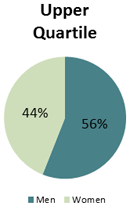
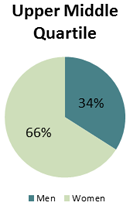
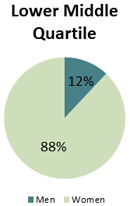
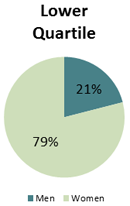
Median and Mean Pay Gap
| Median Pay Gap | This is the difference between the mid-point of pay for male and female employees taking into account all roles within the Society | 26% |
| Mean Pay Gap | This is the difference between the average pay for male and female employees taking into account all roles within the Society | 34% |
Bonus Pay
| Percentage of male employees who received bonus pay | 68% |
| Percentage of female employees who received bonus pay | 74% |
| Median bonus gap - This is the difference between the mid-point of bonus pay for male and female employees taking into account all roles within the Society | 42% |
| Mean bonus gap - This is the difference between the average bonus pay for male and female employees taking into account all roles within the Society | 76% |
What causes the Gender Pay Gap at the Society?
The financial services sector has a higher Gender Pay Gap than other industries due to the balance between male and female employees in senior management positions. There is also pattern of part time and lower paid work which is at present predominately female and which reflects themes that are prevalent in many industries. These pattern are is reflected in the Society’s figures.
What action is the Society taking to reduce the Gender Pay Gap?
This year we can report a marked improvement in the Mean pay gap which illustrates the difference between average pay for males and female employees, this has improved from 42% to 34%.
We recognise the benefits that a diverse workforce can bring and have sought to create a culture that attracts, retains and encourages talented people to deliver outstanding performance. Whilst giving active consideration to the balance between male and female employees in senior roles, we believe it is important that appointments are made on merit and against objective criteria.
The Cumberland has signed up to the Women in Finance Charter which commits firms to supporting progression of women into senior roles in the financial services sector. We have set an internal target of having at least 33% of women at Executive and Board Level by April 2021. As at December 2018, the percentage of female employees at Executive and Board Level was 19%. During 2019 there was changes in the composition at our most senior executive level. Females now represent 25% at this level.
We have put into place a Diversity and Inclusion Working Group who continue to review policies and procedures to identify any issues/barriers why women are not applying or progressing into more senior roles. A more flexible approach to working has already been introduced in many areas of The Cumberland where possible and we have enhanced our family friendly schemes.
During 2019 we have insisted on diverse short lists when using external recruitment partners and we also now ensure that the recruitment interview panel for all roles has female and male representation. We have made a commitment as a foundation partner to a Diversity Research Project through Lancaster University in conjunction with the Work Foundation.
We have undertaken unconscious bias training for all our employees through an external company. A Leadership Development programme is also currently running which will assist with promoting progression within The Cumberland.
I can confirm that the information shown above is accurate and in accordance with The Equality Act 2010 (Gender Pay Gap Information) Regulations 2017 in relation to the pay period including 5 April 2019.
Jill Johnston
Chief People Officer

Pay Quartiles
Pay Quartiles show the balance between male and female staff at different levels of pay. Employees are split into four equally sized groups based on their hourly rate of pay and the following charts show the percentage of men and women in each group. For example, 39% of employees in the highest paid group (the Upper Quartile) are women and 61% are men.
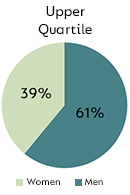
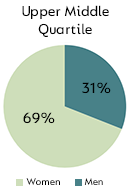
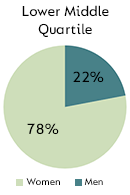

Median and Mean Pay Gap
| Median Pay Gap | This is the difference between the mid-point of pay for male and female employees taking into account all roles within the Society | 26% |
| Mean Pay Gap | This is the difference between the average pay for male and female employees taking into account all roles within the Society | 42% |
Bonus Pay
| Percentage of male employees who received bonus pay | 72% |
| Percentage of female employees who received bonus pay | 78% |
| Median bonus gap - This is the difference between the mid-point of bonus pay for male and female employees taking into account all roles within the Society | 52% |
| Mean bonus gap - This is the difference between the average bonus pay for male and female employees taking into account all roles within the Society | 82% |
What causes the Gender Pay Gap at the Society?
The financial services sector has a higher Gender Pay Gap than other industries due to the balance between male and female employees in senior management positions. This is reflected in the Society’s figures. The figures due to be published for 2018 do not take into account the changes at Executive Director level during 2018 which will show a marked improvement to the figures.
There is no difference in the rate of pay between male and female staff undertaking the same, or a similar, role.
What action is the Society taking to reduce the Gender Pay Gap?
We recognise the benefits that a diverse workforce can bring and have sought to create a culture that attracts, retains and encourages talented people to deliver outstanding performance. However, whilst giving active consideration to the balance between male and female employees in senior roles, we believe it is important that appointments are made on merit and against objective criteria.
In 2018 when we signed the Women in Finance Charter at which point we had 19% of women at Executive and Board Level. Since then we have made good progress and as at September 2019 this is 25%. Our target is to reach 33% by 1st April 2021. We intend to reach this target through a combination of diverse shortlisting at senior level and a continual commitment to review our policies and practices, including the embedding of our core values through the organisation.
In 2018 a Diversity and Inclusion Working Group was formed to continually review policies and procedures to identity any issues/barriers as to why women are not applying or progression into more senior roles. A more flexible approach to working was been introduced where possible and we have enhanced our family friendly schemes.
I can confirm that the information shown above is accurate and in accordance with The Equality Act 2010 (Gender Pay Gap Information) Regulations 2017 in relation to the pay period including 5 April 2018.
Jill Johnston
Chief People Officer

Pay Quartiles
Pay Quartiles show the balance between male and female staff at different levels of pay. Employees are split into four equally sized groups based on their hourly rate of pay and the following charts show the percentage of men and women in each group. For example, 47% of employees in the highest paid group (the Upper Quartile) are women and 53% are men.
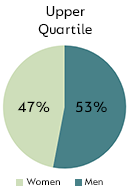
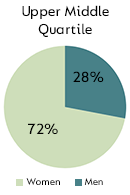
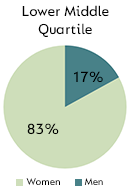
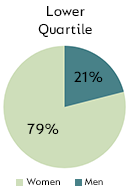
Median and Mean Pay Gap
| Median Pay Gap | This is the difference between the mid-point of pay for male and female employees taking into account all roles within the Society | 27% |
| Mean Pay Gap | This is the difference between the average pay for male and female employees taking into account all roles within the Society | 41% |
Bonus Pay
| Percentage of male employees who received bonus pay | 76% |
| Percentage of female employees who received bonus pay | 75% |
| Median bonus gap - This is the difference between the mid-point of bonus pay for male and female employees taking into account all roles within the Society | 54% |
| Mean bonus gap - This is the difference between the average bonus pay for male and female employees taking into account all roles within the Society | 79% |
What causes the Gender Pay Gap at the Society?
The financial services sector has a higher Gender Pay Gap than other industries due to the balance between male and female employees in senior management positions. This is reflected in the Society’s figures. Unlike most financial services companies who have reported their Gender Pay Gaps, we have an almost even split between male and female staff in the highest paying group (the Upper Quartile). However, there is a greater proportion of men in the most senior positions, which creates the gap on mean, median and bonus pay.
There is no difference in the rate of pay between male and female staff undertaking the same, or a similar, role.
What action is the Society taking to reduce the Gender Pay Gap?
The Nomination Committee is particularly mindful of the diversity of the Society’s senior staff. We recognise the benefits that a diverse workforce can bring and have sought to create a culture that attracts, retains and encourages talented people to deliver outstanding performance. However, whilst giving active consideration to the balance between male and female staff in senior roles, we believe it is important that appointments are made on merit and against objective criteria.
The progression of women to senior positions within the financial services industry is a long standing issue which affects the number of female applicants for these roles. We have undertaken a number of national searches for Executive and Board roles over the last year, working in conjunction with a specialist recruitment agency, but the number of women applying for these positions has been very limited. It is therefore particularly important to ensure that we are encouraging the development of all staff and do not inadvertently put any barriers in place which could discourage female staff from applying for and progressing to the most senior positions.
We are undertaking a review of our current approach and policies to ensure this is the case and are encouraged by the fact that the Society has broadly equal split between male and female staff in the highest paid group.
I can confirm that the information shown above is accurate and in accordance with The Equality Act 2010 (Gender Pay Gap Information) Regulations 2017 in relation to the pay period including 5 April 2017.
Chris McDonald
Operations and HR Director